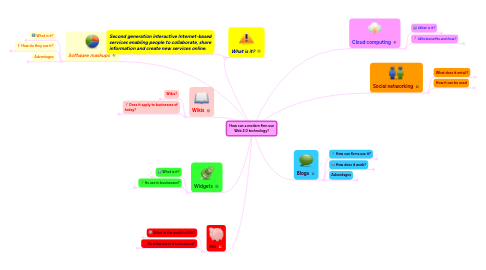
1. Cloud computing
1.1. What is it?
1.1.1. Model of computing where a firm and individuals obtain computing power and software applications over the internet, rather than purchasing their own hardware and software
1.2. Who benefits and how?
1.2.1. Small and medium sized businesses can use this Web 2.0 technology to reduce costs as they do not have to use their infrastructure. They can use their own hardware and software for their core activities and adopt cloud computing for less critical systems therby reducing the need to acquire large amounts of capital.
2. Software mashups
2.1. What is it?
2.1.1. Software services that enable users and system developers to mix and match content or software components to create something entirely new
2.2. How do they use it?
2.2.1. Design innovation: they can use it to test new ideas as well as improve on existing ones using new ideas
2.2.2. As they create their own personalised application using mashups they can create a brand image which can help with brand loyalty as well as attract new customers.
2.3. Advantages
2.3.1. Uses the Web itself instead of on the desktop and brings the vision of Web-based computing closer to realisation
2.3.2. Gives businesses that us it a competitve advantage as they become more innovative and flexible to customer wants and demands
3. Blogs
3.1. How can firms use it?
3.1.1. It can be used to help executives communicate with employees who can give management feedback about job conditions and their grievances thus creating better relationships. It can also be used as a formal way of communication where management posts notices or announcements on blogs.
3.1.2. Most sites allow new users or visitors to subscribe evryday. They can use this as an interface for reaching out to customers and provide a personal and conversational way to provide information The business can therefore use blogs as a way to obtain feedback from visitors and customers, as they can add comments to the original content
3.1.3. They can also use blogs too help them with market research, product development and market demand trends, as well as reduce the costs associated with them. This is because they can analyse blogs to see what is being said online about new products, old brands and advertising campaigns. Blog-watching services are cheaper and faster for analyzing consumer interests.
3.1.4. They can use blogs to post advertisements that spark interest and therefore attract cutomers to their products.
3.2. How does it work?
3.2.1. Informal yet structured web site where subscribing individuals can publish stories, opinions and links to other web sites of interest
3.3. Advantages
3.3.1. Product development and market research made easer
3.3.2. Lower costs to the business
3.3.3. Feedabck channel for customers and employees
4. Widgets
4.1. What is it?
4.1.1. Small software programs that can be added to Web pages to provide additional functionality
4.2. Its use in businesses?
4.2.1. Can be used for advertising purposes as it provides a storefront window for selling their goods and services. The businesses can include more information about the product as well as allow the customer to try out new product functions via a widget.
4.2.2. Advantages
4.2.2.1. Allows the business to advertise other products without overcrowding their web page.
5. What is it?
5.1. Second generation interactive Internet-based services enabling people to collaborate, share information and create new services online.
6. Wikis
6.1. Wikis?
6.1.1. Collaborative websites where visitors can add, delete or modify content on the site, including the work of the authors
6.2. Does it apply to businesses of today?
6.2.1. They can share sales information on a Wiki instead of developing a different folder for every client
6.2.2. They can use it as a storage for the files and folders that are used by all employees.
6.2.3. Can be used to share memos with employees as well as receive memos from employees
6.2.4. Also provides an interface for customers to air their views on the business' products if they are regularly monitored.
6.2.5. They can acquire new innovative information about their business and their products from employees or customers that visit the wiki
7. RSS
7.1. What in the world is RSS?
7.1.1. Reall Simple Syndication: It is a system that syndicates websites so that it can be used in another setting. It pulls specified content from websites and feeds it automatically to user's computers where it can be stored for future use.
7.2. So what use is it to business?
7.2.1. Businesses use RSS internally for communication purposes such as to distribute updated corporate information to the relevant employees.
7.2.2. Use RSS to deliver newsfeeds that employees can customise to see the business news of greatest relevance to their jobs
7.2.3. Advantage
7.2.3.1. Communication is made easier internally
8. Social networking
8.1. What does it entail?
8.1.1. Using the Internet to communicate and join people from all over the world
8.2. How it can be used
8.2.1. Businesses can place adverts on the social networks about their new products and services
8.2.2. It can be used to connect and interact with employees and other businesses thereby improving the relationships between them.
